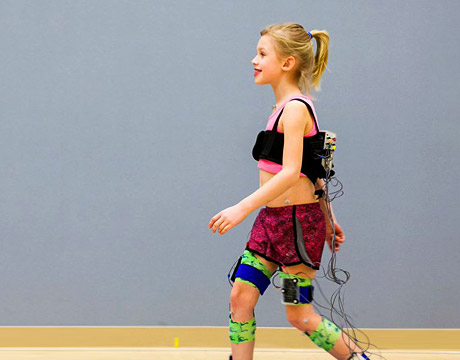Hoping to Walk This Way
Hoping to Walk This Way


Walk-DMC, a new, quantifiable measure of motor control in children with cerebral palsy. Image: Michael Schwartz / Gillette Children’s Specialty HealthCare
As the school year begins, students may be considering all the challenges that come along with it. Who will be in my class this year? Can I keep up with the homework? Will I like my teacher? What a student probably doesn’t have to think about is whether they’ll have to endure an invasive surgery and if they’ll have the ability to walk from classroom to classroom. For a child with cerebral palsy, this can be their primary concern.
“You see a lot of variability among individuals trying to figure out the best treatment for them, which is usually different types of surgeries,” says Kat Steele, an assistant professor of mechanical engineering at the University of Washington. “But these surgeries can have a difficult and long recovery. It could be lengthening muscles, working with bones, and more.”
Clinicians have believed that motor control matters in terms of a surgery’s success, according to Steele, and that those who have a higher level of control at the outset tend to do better after surgeries, while those with a lower level of control tend to have less success. “But they have often decided who has good motor control by observation,” she says. “Only some who have these surgeries do well, so by being able to more accurately figure out who has good motor control, people can have this information for deciding if they think a surgery is worth it.”
Enter “Walk-DMC,” a new motor assessment tool.
Using electromyography, the thought was to come up with a single score to help tell whether a patient is more or less likely to benefit from surgery. “It involved an algorithm called a matrix factorization to help create the score,” she explains. Another important strategy of Walk-DMC is that it takes into account muscle synergies instead of just the movement of individual muscles.
The team found by studying hundreds of children that those with higher Walk-DMC scores did, in fact, have better outcomes from surgery. They also saw that you could have a similar Gait Deviation Index and yet your Walk-DMC could be very different.
But while that may possibly help those with high scores, there is more to look at. Questions to ponder, Steele says, revolve around if there are rehabilitation possibilities or other strategies that can change motor control for those with cerebral palsy, or are those synergies actually fixed.
“It’s very invasive what these children go through, it can take more than a year of rehabilitation and it’s not easy to ask them to endure these things,” she says. “The goal isn’t just to deliver assessment to those who are considering surgery but to look at how many possible solutions there are for all. All the children deserve a chance at improvement and we’re committed to looking at cerebral palsy from different angles.”
Steele says they are now testing prospectively to see if Walk-DMC can help and are also now working with a few hospitals to see if they get similar results. “This should give us even a better sense of the clinical utility and it will be interesting to see what the data is.”
Eric Butterman is an independent writer.
All the children deserve a chance at improvement and we’re committed to looking at cerebral palsy from different angles.Prof. Kat Steele, University of Washington




